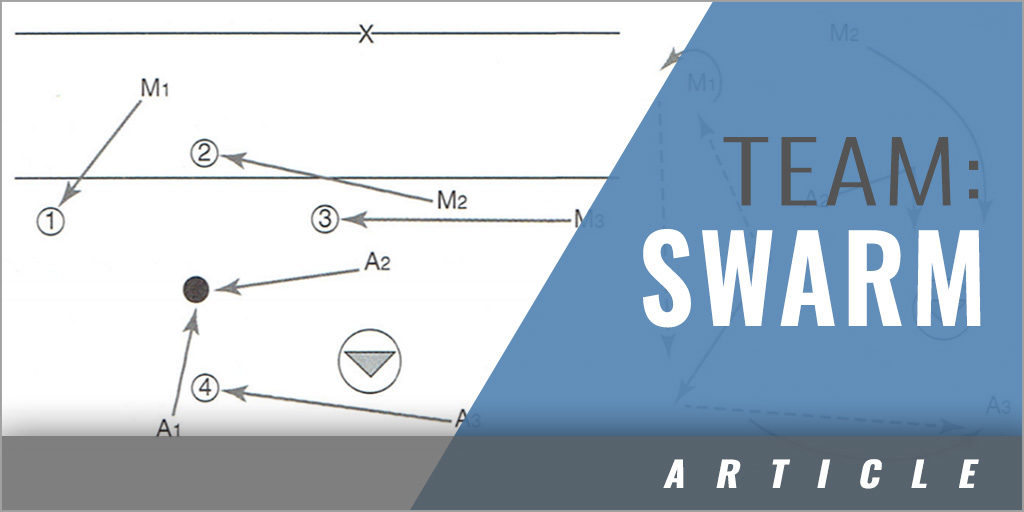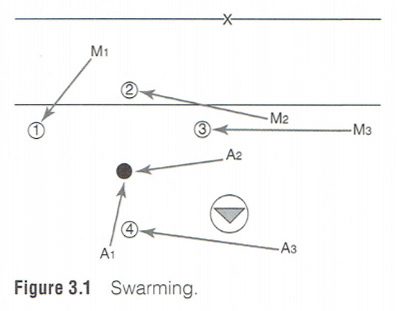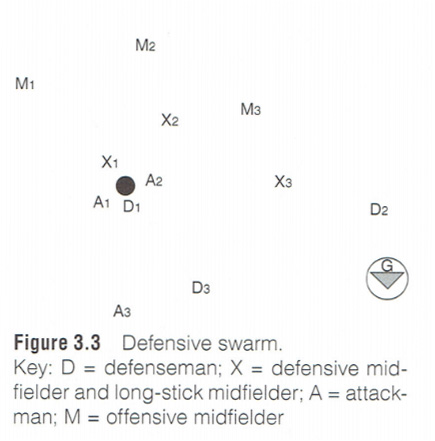|
By: Jack Kaley and Rich Donovan Originally Published in: Lacrosse Essentials Provided by: Human Kinetics Swarming refers to a team concept in which all six offensive players react to all loose balls in their offensive half of the field. The two players closest to the ball must react as quickly as possible and go directly to it to get possession. The other four players all have lanes and spots they must fill as quickly as possible. Teams want two players on the ball, three players in an umbrella 10 yards from the ball upfield, and one player 10 yards from the ball directly downfield. Three players upfield prevent the opposing team from gaining possession of the ball and initiating a transition. The offense has an advantage on loose balls because all defenses are taught to play between the goal and the offensive player they are covering. The offense will have at least one extra man to participate in the swarm, putting them in better position to either come up with possession or check the defensive players who might have position on the ball. That extra man is usually the offensive creaseman because not only is he usually close to the ball, but also his defensive player is responsible for the defensive hole. The defensive hole is the defensive area directly in front of the crease. The aim is not only to outnumber but to also outhustle the defensive players (see figure 3.1).
Figure 3.1 shows three midfielders in the umbrella and two attackmen closest to the ball. In situations in which one midfielder or more is closest to the ball, the attackmen have to fill in those positions in the umbrella. For example, if M2 and Al are closest to the ball, M3 fills the number 2 spot in the umbrella, and A3 fills the number 3 spot. The offensive formation and the location of the loose ball determine which players are closest to the ball and who must fill the three positions in the umbrella. The closest man to the sideline is always responsible for the number I spot. The next closest man is responsible for the number 2 spot, and the man farthest from the ball occupies the number 3 spot. All three men in the umbrella are approximately 10 yards above the ball. They call "help" to their teammates who are fighting for the ball to let them know they are in position so their teammates can redirect the ball to them.
Offensive swarming is the most important aspect of a lacrosse game. The following statistics illustrate my point. In December of 2003, I was asked to speak at the United States Intercollegiate Lacrosse Association (USILA) national convention. I was given the opportunity to select my topic, so I chose ground balls and team swarming. In preparation for this presentation I did a 10-year analysis of our ground-ball and clearing and riding statistics. I was astounded by the results. I knew all along that we had dominated ground balls, but I never realized to what extent. I used the period from 1994 to 2003. During this period we averaged 17 more possessions per game than our opponents from ground balls. This equates to eight or nine shots a game and probably three or four goals. I retired after the 2009 season with a 17-year winning percentage of 84. I attribute this primarily to our ground-ball dominance. The most important thing about this aspect of the game is that any team can excel at it. It doesn't take skill, speed, or great stick work to master it. It only takes hard work, hustle, and perseverance by players and the coaching staff. Defensive Swarm Swarming on the defensive half of the field is different from swarming on the offensive half. In fact, technically speaking, it is not a swarm of the complete defense. Only the defensive player directly in the area of a loose ball can aggressively go after the ball. The other defensive players must remain at their positions between the man they are covering and the goal. Therefore, the defense is usually outnumbered in terms of proximity to the ball, so the offense should have an advantage in terms of numbers and positioning on the ball (see figure 3.3).
|










